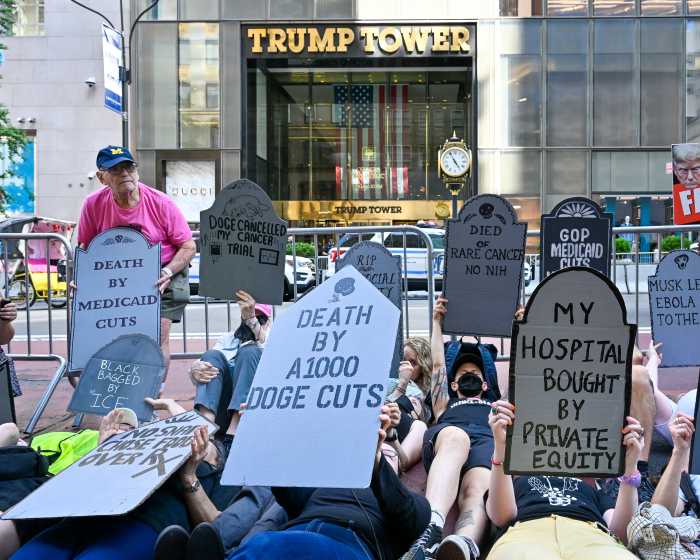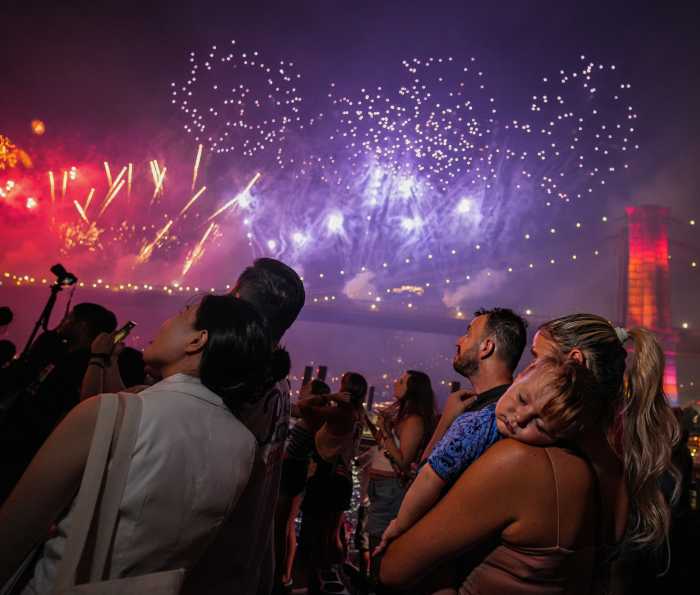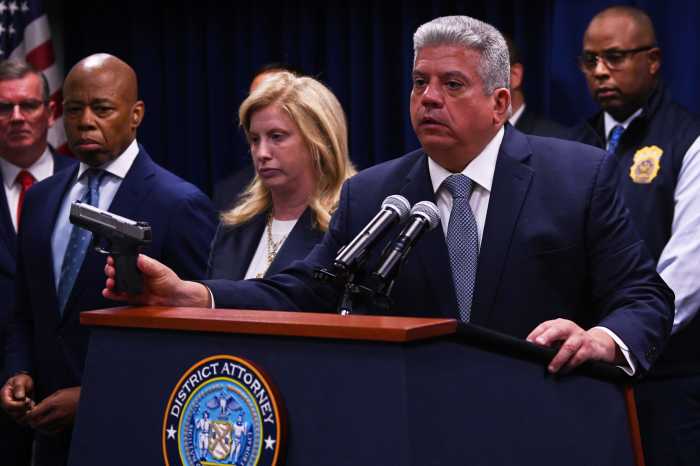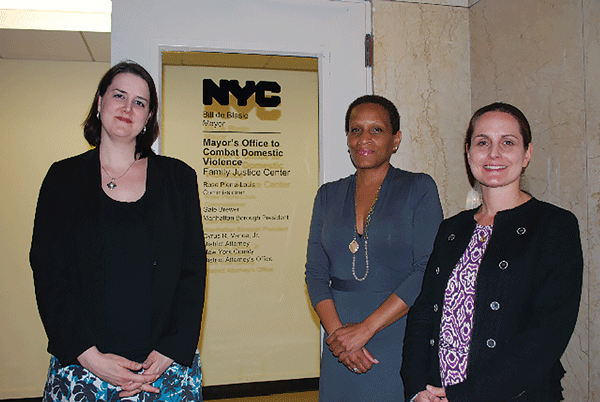
L to R: Asst. Commissioner Tracy Weber-Thomas, Commissioner Rose Pierre-Louis, and Executive Director Hannah Pennington of the Manhattan Family Justice Center at the Mayor’s Office to Combat Domestic Violence.
BY WINNIE McCROY | At the March 26, 2014 meeting of the 10th Precinct’s Community Council, representatives from the Mayor’s Office to Combat Domestic Violence (OCDV) surprised some attendees when they noted that, year-to-date, upwards of one-third of Chelsea’s felony assaults were attributed to domestic violence.
“This is a lower number of assaults as compared to busier precincts; it’s a nicer neighborhood,” said 10th Precinct Sergeant Erin McMorrow, when questioned about the March stats. “All around, crime is a lot less in Chelsea than in other neighborhoods.”
Last week, McMorrow told this newspaper that there were 41 year-to-date assaults in the 10th Precinct as of May 30, 2014 — 20 of which can be attributed to domestic violence.
Just to give readers an idea of how this compares to rates of felony assaults in the past, CompStat provides the historical perspective statistics of 301 felony assaults for 1990, and 98 felony assaults for 2013. Those numbers reflect a -67.4 percent reduction in felony crimes — including domestic violence assaults — in Chelsea during that time period.
Tracy Weber-Thomas, Asst. Commissioner for the OCDV, confirmed that citywide in 2013, 40 percent of all felony assaults were domestic violence-related. In the 10th Precinct, those stats reveal that 30 percent of felony assaults are domestic violence-related.
Does that mean that domestic violence isn’t a big problem in Chelsea? No. As Weber-Thomas quipped, “even one felony assault that’s domestic-violence-related is one too many.”
CAUSES AND PATTERNS OF DOMESTIC VIOLENCE
Intimate partner violence isn’t caused by stress, mental illness, drugs or alcohol use. It is a pattern of coercive behavior used by one partner to establish and maintain control over another. It often includes violence, but not always. Some victims of intimate partner abuse might not want to leave their partner. And some might not even realize that they are in an abusive relationship.
“Domestic violence is not just a black eye,” said OCDV Commissioner Rose Pierre-Louis. “People are engaging in a pattern of abuse and control that is beyond the physical. Sometimes financial abuse or identity theft is prevalent.”
An abusive situation may include threats of violence or intimidation to the victim or their child, extended family member, or pet (the OCDV’s new program will shelter domestic violence victims with pets). An aggressor may threaten to call the police or the U.S. Immigration and Customs Enforcement on an undocumented worker, or force them into prostitution under threat of deportation (trafficking is a big issue in Queens, comprising 60 of the OCDV’s 100 cases).
Experts also say that many young people, inexperienced with relationships and desensitized to violence, may not realize that it’s not healthy if they are being intimidated, threatened, put-down, manipulated, or humiliated.
“If you experience any of these things, that’s abuse and we can help,” said Pierre-Louis.
Recent laws are evolving to address these types of abuse; a year and a half ago, the New York State Penal law changed to include strangulation (defined as a criminal obstruction of breathing or blood circulation) as a felony assault.
“It’s about understanding the dynamics of domestic violence and ensuring there’s a legal remedy so that when you’re seeing this happen there’s a recourse. Expansion of statute allows it to be more specific, easier for practitioners, police, civil and legal services to have clarity,” said Pierre-Louis.
Similar clarifications are in the works for offenses like identity theft, online stalking, harassment, and even the use of technology such as tracking a victims’ location via mobile GPS.
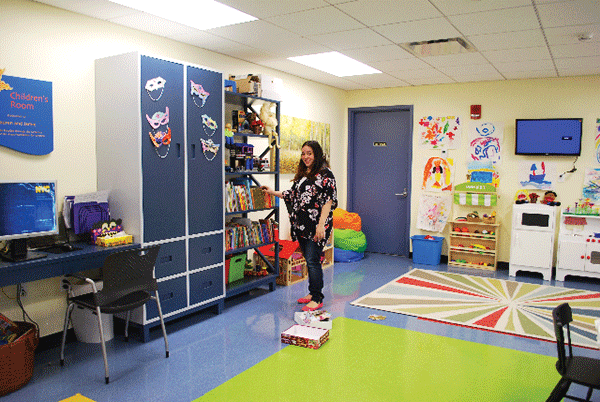
A worker from the Mayor’s Office to Combat Domestic Violence watches clients’ kids as they access services.
Domestic violence assaults continue to be a major problem all across the city, threatening home life. It affects rich and poor, black and white, gay and straight alike. All of these groups live side by side in Chelsea, and all are affected by domestic violence and/or intimate partner abuse.
It’s important to remember that while the CompStat figures give us a glimpse into the problem of domestic abuse today, they only paint part of the picture. True, some victims of domestic violence call the NYPD for help — but others don’t. Higher-income people may have the resources to go through legal or civil channels if they want to leave their abusive partner. Undocumented immigrants may be afraid or suspicious of the police, and may instead seek services from groups like the OCDV.
“When we’re talking about domestic incident reports, that is an indicator of people who have reached out to law enforcement for assistance with the violence that’s happening in their home,” said Pierre-Louis. “So when we’re saying that Chelsea has lower numbers of domestic violence, I’d say that interventions by law enforcement officials may not be the first line of response that residents in Chelsea are using.”
Pierre-Louis said that last year, New York City had 280,000 incidents of domestic violence reported to the police. But she noted, “That doesn’t count people who went to the emergency room or to counseling or other interventions. It is not even capturing that number, so when we talk about the issue of domestic violence and how big it is, we have to remember that these numbers just reflect the law enforcement side.”
Shelby Chestnut, Co-Director of Community Organizing and Public Advocacy at the Anti-Violence Project (AVP), also pointed out that the cycle of violence is condoned in our society, where multiple forms of violence can intersect. The battered women’s movement comes out of the fact that societally and historically, men were legally allowed to beat and rape their wives.
But New York City is providing the resources to combat this epidemic. We have the largest network of Family Justice Centers in the U.S. and perhaps the world. The city recently committed $30 million to the OCDV. All NYPD officers are trained on how to deal with domestic disputes, each precinct has two Domestic Violence Police Officers (DVPO) on staff, and the NYPD has a Domestic Abuse Unit, all to help keep people safe from intimate partner violence.
WHAT HAPPENS WHEN YOU CALL THE POLICE?
If your partner is abusing you, should you call the police? The choice is ultimately up to you, but if you do dial 911, this is what will happen: The NYPD will dispatch two patrol officers to your residence. They will do a series of assessments to determine what has happened, and then decide whether any arrests need to be made.
Unlike in some cities, New York doesn’t require that all parties be arrested at the scene of a domestic dispute — a situation that Pierre-Louis characterized as “revictimizing the victim.”
“To the NYPDs credit, there are assessments they do that trigger when an arrest needs to happen,” said Pierre-Louis. “They might walk into a situation where there are wounds sustained by both parties, but some might be defensive wounds. Police are trained to recognize these.”
The patrol officers then share resources with the victim, directing them to call the Domestic Violence Hotline or 311, which will connect them with local resources like the OCDV.
If the victim has never before filed a police report, they might explain their home situation to a caseworker. An onsite DVPO will take their statement and engage with that person’s local police precinct to file a report. If, on the other hand, the primary aggressor is a repeat offender, the NYPD has a process in place to handle high-risk cases. For example, if the police department is called to the same place multiple times in a month, the case will be moved to a high-risk status. OCDV will work with DVPOs to form a safety plan and plan of action, so that the victim is “surrounded in terms of services, with all of them moving in the same direction,” as Pierre-Louis describes.
“It’s not about telling a victim what they need. But we do know that the police department tells people things like, ‘I’m not sure you realize this but the violence is escalating. We know in situations like this, there is a high likelihood of lethality or serious harm to you or family. Is it okay if someone reaches out to you?’ ” said Pierre-Louis.
Police technology reveals the repeat offenders, but local police precincts are often already aware of those within their jurisdiction, with Pierre-Louis saying, “They can rattle off the names of abusers for you; they know who’s in their area.”
DVPOs are involved in these high-risk cases, and often have a strong relationship with the victim through regular engagement so that they can help move toward an intervention. The Family Justice Center makes sure that the NYPD gets victims connected with resources that can help.
“The benefit of us going to all 77 Precinct Community Council meetings is not only to let community residents know about us, but to let patrol officers and other folks know about these resources,” said Pierre-Louis.
THE MANHATTAN FAMILY JUSTICE CENTER
In March, the OCDV celebrated their grand opening of the Manhattan Family Justice Center, (FJC), complete with a facelift. The Center is located at 80 Centre St., and positioned strategically across the hall from District Attorney Cyrus Vance and his Special Victims Unit.
Commissioner Rose Pierre-Louis notes that the OCDV was actually established in 2002, and operates four FJCs in Manhattan, Queens, the Bronx, and Brooklyn, and will open a Staten Island branch by the end of 2015. They are designed to help coordinate domestic violence services, work with other agencies, do community outreach and advocate on legislative issues.
As part of their new office design, the FJC is now a one-stop shop, with one-on-one counseling and resources, and a therapeutic environment for kids to play in while the parents are getting support, so that the child won’t have to relive the traumatic event.
“We don’t tell victims what they need to do; we inform them about what their rights are, what resources are available and what means they have to secure public benefits or housing,” said Pierre-Louis.
Pierre-Louis has a crack team at work, but spends most of her time out of the office, spreading the news about the resources the OCDV offers to elected officials, police officers and the community.
“I have been going to all 59 Community Board Council meetings, most precinct Community Council meetings, and meeting with most elected officials in New York City, because I think it’s important for them to understand what’s happening in terms of domestic violence,” she said.
Many people, picturing the archetype of the “battered wife,” and not reconciling that with themselves, may have a difficult time viewing their relationship as abusive — especially if the abuser is of the same gender.
LGBTs AND DOMESTIC VIOLENCE
According to the National Coalition of Anti-Violence Programs, intimate partner abuse happens at the same rate in the LGBT community as it does in the heterosexual community. Chelsea has a history of being a haven for gay men, but the NYPD doesn’t keep tabs on whether local victims of abuse are LGBT or not.
“We don’t know whether it’s same-sex assaults or not; that’s not something we track,” said the 10th Precinct’s Sgt. McMorrow.
And while some LGBT victims of domestic abuse might call 911 on their abuser, many choose instead to seek help at a gay-oriented resource like the New York City AVP. Chestnut says that rates of abuse in Chelsea seem large in proportion to the number of felony assaults there, but that overall, domestic violence is not quite as big of a problem in Chelsea as in other parts of the city.
“Chelsea is historically known as gay men’s neighborhood, and although we know this violence exists in all communities, you have to factor in the real difference between an upper middle-class white man calling the police for assistance as opposed to a transgender, homeless youth of color in the West Village calling for help,” said Chestnut. “LGBTs don’t historically have great interactions with the police, but some have better interactions than others, and this is a community that might feel safer reporting it.”
The NYC AVP notes that from the time period between January 1 and April 30, 2014, they served 283 clients who reported experiencing intimate partner violence.
Some LGBT aggressors may dissuade their partner from reporting this violence by threatening to “out” them as gay or trans to their employer, or to withhold hormones from a transgender partner as a way to maintain control.
“You must factor in the many ways that hate violence and homophobia is key in these situations,” said Chestnut. “The power and control issues can look different from mainstream violence but still have an impact.”
In addition, when domestic violence happens between partners of the same gender, police may not recognize who is the primary aggressor. Chestnut said that when two female partners are involved in a domestic assault, police often arrest the “butch” or masculine-identified partner.
Chestnut also noted that those LGBTs most impacted by partner violence — transgender people, people of color, and young gay men — are those who are least able to access resources.
“The domestic violence movement is seen as a women’s issue,” said Chestnut. “Here in New York, we have four beds set aside for LGBT victims of domestic violence, and it is quite a challenge to get people placed. Ninety percent of these shelters are women-only, so if you’re a gay man calling to get into a shelter, you’re not going to think you’re welcome. You’re just not able to access services at the same rate.”
On average, the NYPD responds to 770 domestic violence calls every day citywide, and had 280,000 domestic incident reports filed last year. Although these statistics represent only a part of the problem, the OCDV and other groups are committed to addressing the spectrum of violence in the city, be it domestic abuse, hate crimes, rape or other gender justice issues. Everyone has the right to live in a home that is free of violence.
“We want people to seek help,” said Pierre-Louis. “When I see that 280,000 people reached out to the NYPD last year, I don’t see that as an awful indication of the high rates of domestic violence. I see that as a great thing, because people are finally reaching out for help.”
For more information, visit facebook.com/nysdomesticviolence. For help from the Family Justice Center near you or to support the Family Justice Center Initiative, visit nyc.gov or call 311. Victims of domestic violence are encouraged to call the Manhattan District Attorney’s Domestic Violence Hotline, at 212-335-4308.



